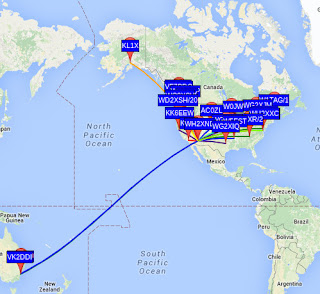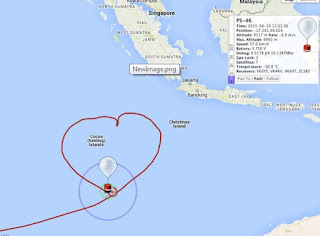Posts Tagged ‘WSPR’
 630m Trans-Pacific Path Alive
630m Trans-Pacific Path Alive

In spite of the recent high levels of geomagnetic disturbance (or maybe because of it), just as it did last year at this time, the path between North America and Australia has sprung to life once again. Last night saw the reception of both WH2XND (NI7J), in Phoenix and WG2XXM (K5DNL), near Oklahoma City, by VK2XGJ in New South Wales, Australia. Not to be left out, VK2DDI, also in NSW, copied WG2XXM as well. Some of K5DNL's 630m gear can be seen here.
 |
| courtesy: John Langridge (WG2XIQ / KB5NJD) |
The American beacons were operating in the WSPR mode, which has become very popular amongst 630m experimenters as well as those just interested in listening-in. WSPR is not a QSO mode but strictly a one-way 'beacon' mode. Although two stations may each spot each other, it is not considered to be a valid two-way QSO. A check of evening WSPR activity will often reveal dozens of stations actively spotting what they are hearing.
VK2DDI runs the Berry Mountain Grabber, providing other VK and ZL experimenters a handy way of checking their system progress or propagation conditions but during good T-P nights, it can be a good place for U.S. stations to watch for their signals as well.
If you have been doing any WSPR work on HF, you might be surprised at what you can hear down on 630m, even without a dedicated antenna for that band. Surprisingly good results can often be had with a non-resonant antenna as the signal to noise ratio can often be better even though signals may sound weaker. Give it a try and spot what you hear!
If you are interested in learning how to receive WSPR, here is a nice tutorial by ZS6SGM.
Should you be interested in knowing more about obtaining a Part 5 licence to transmit on 630m, John, KB5NJD / WG2XIQ, has a wonderful 630m resource page here, as well as more details about the recent down-under receptions. While there, be sure to check out his up-to-date 630m links page. He can be contacted via email or you can find him hanging-out most nights on the ON4KST kHz (2000-630m) chat page.
To keep on top of what is happening or who is on-the-air, most LF'ers rely on three sources:
- the RSGB LF Group reflector
- the Lowfer list
- the LWCA Message Board
Radio amateurs in Canada have had 630m as an amateur band since May of last year but unfortunately are not allowed to contact any of the experimental stations. Hopefully the U.S. will also obtain 630m as a ham band some time soon. In the meantime, a Part 5 licence for any U.S. amateurs would be a good way to be all set when that day eventually comes!
 Lincoln President Mk2
Lincoln President Mk2
 I have owned this rig for several months now but it hardly get used as I prefer, because of my poor voice, to run my WSPR beacon on 10m. It certainly works well with my last QSO being a W8 on SSB.
I have owned this rig for several months now but it hardly get used as I prefer, because of my poor voice, to run my WSPR beacon on 10m. It certainly works well with my last QSO being a W8 on SSB.
In the picture, the small WSPR beacon is far left with the Lincoln with green illumination on the left of the FT817s and to the right of the WSPR beacon.
 Andy’s Balloons
Andy’s Balloons
 Like Timex watches, the incredible Picosat balloons of Andy, VK3YT, 'take a licking and keep on ticking'. On May 23rd, Andy launched his PS-46 HF Pico balloon and on June 4th it had arrived back home, completing the circumnavigation of the earth in just 12 days ... but it kept on going. Although taking a little longer this time 'round, PS-46 arrived back over its starting longitude exactly one month later, on July 4th, completing its second circumnavigation of the planet! It slowed briefly enough over the Indian Ocean to trace out this interesting ground track.
Like Timex watches, the incredible Picosat balloons of Andy, VK3YT, 'take a licking and keep on ticking'. On May 23rd, Andy launched his PS-46 HF Pico balloon and on June 4th it had arrived back home, completing the circumnavigation of the earth in just 12 days ... but it kept on going. Although taking a little longer this time 'round, PS-46 arrived back over its starting longitude exactly one month later, on July 4th, completing its second circumnavigation of the planet! It slowed briefly enough over the Indian Ocean to trace out this interesting ground track. |
| courtesy: http://picospace.net/ |
PS-46 can be tracked via HF packets delivered via JT-9 and WSPR. Frequency information and tracking notes can be found on Andy's website for those interested in tracking the balloon themselves. As well, its track (and other balloons) can be followed on the Spacenear.us website. I think Andy's balloons are very cool and demonstrate a new aspect of amateur radio that was completely unheard of just a few years ago.
Go PS-46!
 I fancy some 472kHz WSPR!
I fancy some 472kHz WSPR!
It is ages since I was active on 472kHz, so I might fire up the FT817 and transverter to see if anyone can spot my 5mW ERP or I can spot others. I shall use the earth-electrode “antenna” and go QRT on 6m to free up the FT817.
It is summertime, so noise levels will be higher, making my weak signal harder to copy than in the winter. It will take me about 5 minutes to swap bands and reset everything. The FT817 has to be set to 500mW and split mode so I receive directly on the 472kHz band but TX on the 80m band into the transverter.
If you copy me on 472kHz WSPR please report it.
UPDATE 2009z: Well, that was a good start! I just switched to MF and received 2 spots by G8HUH in IO81mg (250km) in daylight. I shall now leave 474.2kHz WSPR running overnight to see what else happens. With 5mW (maybe less) ERP I am quite happy with his -26/-27dB S/N reports.
UPDATE 2126z: So far G8HUH (250km) has spotted me 10 times this evening. I have spotted no-one and no-one else has spotted me, as yet.
 WISPY 10m WSPR rig
WISPY 10m WSPR rig
Some years ago (in my fit days) I build a simple DSB WSPR rig for 10m based around a low cost 14.060MHz crystal bought from the GQRP club. The idea was to pull and double this crystal and use it in a simple DSB TX and direct conversion RX. Both TX and RX have been built separately, but I was ill before I got around to combining the 2 into a 10m WSPR transceiver. Both parts worked well.
 The ultimate WSPR spot
The ultimate WSPR spot
A spot reported by K1JT must be the ultimate goal for the WSPR mode. K1JT, Joseph Taylor, is the Nobel laureate who first developed this mode and other related two-way modes like JT65 and JT9.
My 0.1 W 21 MHz WSPR transmitter regularly makes it over the Atlantic, but never before to K1JT. The SWR was something like 7:1, but apparently that works fine, both for the transmitter and for radiation.
The antenna is a 13 m doublet oriented with the broadside facing East-West. I feed it with 450 ohm ladder line to a 4:1 Elecraft balun which is connected to the Ultimate 2 transmitter.
 The ultimate WSPR spot
The ultimate WSPR spot
A spot reported by K1JT must be the ultimate goal for the WSPR mode. K1JT, Joseph Taylor, is the Nobel laureate who first developed this mode and other related two-way modes like JT65 and JT9.
My 0.1 W 21 MHz WSPR transmitter regularly makes it over the Atlantic, but never before to K1JT. The SWR was something like 7:1, but apparently that works fine, both for the transmitter and for radiation.
The antenna is a 13 m doublet oriented with the broadside facing East-West (the EU spots in the figure are from my Ultimate 3 on 21 MHz with another antenna and at another location). I feed the doublet with 450 ohm ladder line to a 4:1 Elecraft balun which is connected to the Ultimate 2 transmitter.














